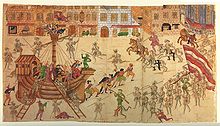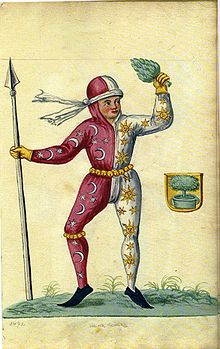Schembartlauf

The Schembartlauf (to mhd. [ Der ] schëm (e) "shadow, mask", schëmbart "bearded mask" folk etymologically Schönbart , hence also Schönbartlauf ), until 1539 part of the Nuremberg tradition on Shrovetide , is first documented in 1449.
According to legend, after a craftsmen's revolt, the Nuremberg butchers were rewarded for their loyalty to the Nuremberg Council with the privilege of holding a Zämertanz on Shrovetide and being allowed to wear face masks, among other things. The original Zämertanz was a performance by the butchers in the tradition of the many artisan dances, in which the dancing men formed a long intertwined chain. Here sausage rings, probably made of leather, were sometimes used as a link from man to man, while other guilds also used swords, hoops or wooden bows with flowers.
Probably the Schembartlauf originally emerged from the accompanying protective force of the butcher's dance and then became independent. The Schembartläufer, masked and singing shoddy songs, marched through Nuremberg during the carnival season. Their dance was more of a run in which simple hopping figures like figures of eight and mills were formed. The runners were accompanied by men who rode horse dummies.
The patrician youth of Nuremberg bought the right to participate (it was probably essentially about the right to mask themselves) from the butchers and thus used the opportunity to present themselves imaginatively. The robes became more and more precious, the Schembartlauf became a great spectacle over the years. In addition to the dance group, individual runners appeared in wild costumes, and from 1475 the Schembart runners pulled a so-called “hell” through the Nuremberg streets, a vehicle on sled runners, with the symbolism of which they more and more the social conditions and - in the final phase - the strict one Protestant regiment mocked.
In 1539 the bustle came to an end after the mockery of the Nuremberg preacher Osiander . 150 runners took part. A large ship served as hell.
More than 80 surviving Schembart books describe the Nuremberg Schembart Runs of the years 1449–1539 in handwritten, chronological and richly illustrated fashion. 35 originals are in Nuremberg libraries, another 30 in other German cities. Individual books have also been preserved abroad.
From the 17th century onwards there were probably isolated performances again, but it was only since 1974 that the Schembart-Gesellschaft Nürnberg performed the Schembart Run regularly, if not every year. The Schembart runners then lead the Nuremberg carnival procession or precede it.
Demarcation
Parallels to other carnival parades throughout Europe exist in the representational elements used here and there, the widespread "carnival-like elements". In terms of origin and organizational form, however, the Schembartlauf is a very special custom in the context of the patrician city of Nuremberg.
literature
- Essays
- Peter J. Bräunlein: The ship as "hell" in the Schembartlauf of 1506. An interpretation in the historical context of Nuremberg . In: Jahrbuch für Volkskunde , Vol. 17 (1994), pp. 197-208, ISSN 0171-9904 .
- Johannes Willers : Carnival and Hell. On the origin of term and thing in the Nuremberg Schembartlauf . In: Jahrbuch für Volkskunde , Vol. 15 (1992), pp. 211-212, ISSN 0171-9904 .
- Hanns Hubert Hofmann : Carnival customs in old Nuremberg . In: Ferdinand Ranft (Ed.): From the Main to the Danube. Contributions from the Franconian regional broadcast of Bayerischer Rundfunk . Spindler, Nuremberg 1961, pp. 12-15.
- Herbert Maas: Schembart and Carnival. A return to old interpretations . In: Mitteilungen des Verein für Geschichte der Stadt Nürnberg , Vol. 80 (1993), pp. 147–159, ISSN 0083-5579 .
- Wilhelm Müller: The Nuremberg Schembartlauf. Origin and Interpretation . In: Archive for History of Upper Franconia , Vol. 62 (1982), pp. 63-91, ISSN 0066-6335
- Eberhard Wagner: The Basel Carnival and the Nuremberg Schembartlauf. Two (comparable) examples of urban carnival customs . In: More beautiful home. Erbe and order , Vol. 80 (1991), Issue 1, pp. 20-24, ISSN 0177-4492 .
- Werner Lenk: Schembartlauf, sword dance and carnival game . In: Ders .: The Nuremberg Carnival Game of the 15th Century. A contribution to the theory and interpretation of the carnival game as poetry (publications by the Institute for German Language and Literature; Vol. 33). Akademie-Verlag, Berlin 1966, pp. 15-20.
- Books
- Jürgen Küster: Spectaculum vitiorum. Studies on the internationality and history of the Nuremberg Schembartlauf (cultural-historical research; Vol. 2). Kierdorf-Verlag, Remscheid 1983, ISBN 3-922055-87-7 (also dissertation, University of Freiburg / B. 1983)
- Jürgen Leibbrand: Speculum Bestialitatis. The animal figures of Mardi Gras and Carnival in the context of Christian allegory (cultural-historical research; Vol. 11). tuduv, Munich 1988, ISBN 3-88073-305-8 (also dissertation, University of Freiburg / B. 1986)
- Veronika Mertens: Mi-Parti as a sign. On the meaning of a divided dress and a divided figure in the class costume, in literary and pictorial sources as well as in Carnival custom from the Middle Ages to the present (cultural historical research; Vol. 1). Kierdorf-Verlag, Remscheid 1983, ISBN 3-922055-86-9 .
- Dietz-Rüdiger Moser : Mardi Gras, Mardi Gras, Carnival. The festival of the "upside-down world" . Edition Kaleidoskop, Graz 1986, ISBN 3-222-11595-8 .
- Hans Ulrich Roller: The Nuremberg Schembartlauf. Studies on the festival and masking of the late Middle Ages (Volksleben; vol. 11). Tübingen Association for Folk Life, Tübingen 1965.

